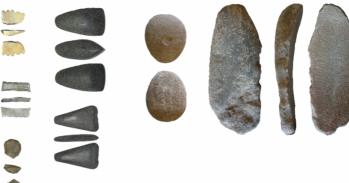
A second season of excavations at Britain’s biggest Iron Age hill-fort has uncovered remains of Roman weaponry, and the site of the first “ham stone” house.
A second season of excavations at Britain’s biggest Iron Age hill-fort has uncovered remains of Roman weaponry, and the site of the first “ham stone” house.
The fort’s construction marked a major transformation of the landscape as a considerable area of farmland had to be abandoned.
Chris Evans, Cambridge Archaeological Unit.
Archaeologists are slowly piecing together a picture of what life was like in Britain’s largest hill-fort, after a second season of excavations.
The project, at Ham Hill in Somerset, is the most intensive excavation of the Iron Age fort ever undertaken, and involves researchers from both Cambridge and Cardiff universities.
Stretching across more than 80 hectares, Ham Hill is by far the largest fort of its kind and one of the most important Iron Age sites in the country. Ironically, however, it is also one of the least understood, as its sheer size means that explaining its meaning and purpose is difficult.
The current project aims to find out more and is taking place over three summers, ahead of the extension of a quarry which harvests “ham stone”, a distinctive, honey-coloured stone which characterises many listed buildings across south England.
Among other things, the latest round of digs has revealed what is almost certainly the first ham stone house in Britain. The 2012 excavations targeted the ramparts that surround and define the hill fort, one on the southern side and two on the northern edge.
These revealed well-preserved deposits that showed the area immediately behind the fort’s ramparts were occupied. On the southern side of the site, researchers found evidence of an Iron Age house built from slabs of the local stone.
Niall Sharples, from the University of Cardiff, said: “None of the houses previously excavated have shown any evidence of stone walls and it was thought that Ham stone was not used as a resource until the Romans arrived in the area. We think that this means we may have found the first Ham Stone house in Britain.”
On the north side of the fort, dumps of rubbish were found deposited against the rampart, containing large quantities of broken pottery and animal bones. Lying on top of the rampart was an iron ballista bolt. These are signs of Roman military occupation of the site in the period immediately after their conquest of the area. Researchers already know that this was common practice in the region as military occupation has also been recorded in the nearby hill forts at South Cadbury and Hod Hill.
The dig has also revealed a large, rectangular enclosure surrounded by evidence of Iron Age activity including roundhouses and grain storage pits. The team have dated this activity to the second to first centuries BCE, the period when the site was densely occupied.
Surprisingly, the analysis threw up very little evidence for settlement activity within the closure’s interior. “Another unusual feature is the deliberate destruction of the boundary,” Chris Evans, from the Cambridge Archaeological Unit, said. “The bank around the enclosure was systematically demolished and an elaborate stone façade that marked the entrance was deliberately dismantled and placed in the ditch.”
“Both the absence of settlement evidence and this act of deliberate dismantling suggest that the enclosure was a special place in the interior, perhaps used for meetings and communal activities which had to be separated from day-to-day domestic work.”
Further excavation uncovered a series of field boundaries underlying the hill fort’s enclosure which date back to the Bronze Age occupation. An earlier geophysical survey had already shown that the whole hill-top was, at some point in the middle of the second millennium BCE, divided into fields. “The fort’s construction therefore marked a major transformation of the landscape as a considerable area of farmland had to be abandoned,” Evans added.
The third and final season of excavations at Ham Hill will be in 2013. The 2012 dig is still underway and members of the public will have the chance to see it for themselves at an open day this Saturday (1 September), when artefacts discovered at the site will also be on display.
This work is licensed under a Creative Commons Licence. If you use this content on your site please link back to this page.





